Makhana or phool makhana are basically roasted and popped seeds of Fox nuts or also known as gorgon nuts in many countries such as Korea, Japan & Russia etc. Fox nuts or gorgon nuts are belong to an aquatic flowering plant or crop called Euryale Ferox salisb which mainly grown in stagnant water of wetland or shallow water bodies, ponds, tanks, lakes & ditches etc that must have a certain amount of organic detritus accumulated at the bottom. The makhana fruit is very rich in Phosphorus, Potassium, Iron, Calcium, Magnesium and amino. It is highly nutritious food that has been used as a snack all over and also used in different recipes especially in Indian cuisines. The importance of this crop is increasing day-by-day due to its high carbohydrate and protein, and low fat content, and also due to its religious offerings.
How fox nuts plant looks like:-
This aquatic flowering plant (Euryale Ferox salisb) has a floating leaves but does not bear any stem. Its rootstalk are short, thick & fibrous consisting 3 to 5 clusters. The full grown leaves are corrugated & deep green in color from the above side but pink or deep purple in color from bottom side of the leaves. The approx. length of leaves are usually 1 to 1.5 metre in diameter whereas its flower violet-blue or dark pink in color.

Pic source-prabhasakshi
About Flower &its seeds: –
Each plant cultivated 15-20 fruits which are round and spongy and prickly from outside. Each fruits carry 20-25nos of seeds which are small(hardly 0.75cm in diameter)& black in color. The seed have hard outer covering around the white edible part. Its seed having hard black seed coat and a mucilaginous aril. The pulpy aril keeps the seeds floating for a few days after they dehisce, before they finally settle down to the bottom of the water
Indian council of Agricultural research (ICAR) has recently developed high-yield makhana seed or fox nut seed called “Swarnavaidehi” which is commercially rich crop


Pic source-check your food & Flickr
Cultivation in India:-
Makahana plan is considered as a native to south east Asian & east Asian countries such as Japan, china, korea, Russia, Nepal, Bangladesh & India.
Since it is an aquatic cash crop in india and mainly grown in the tropical climate naturally or wildly in various part of north Indian state like J&K, Bihar, West Bengal, assam, Manipur, Tripura, Meghalaya, orissa, M.P and some part of Uttar Pradesh such as Gorakhpur. But commercially it is mainly cultivated in North Bihar specially in Mithilanchal district area where more than 80% of total cultivation in India is cultivated in these district alone.
It is a seasonal annual crop which dies out after its fruit matures. Its plant mainly grow in wetland of standing shallow water which should have minimum 2.5 mtr depth. It require 25-35degree C temperature and humidity between 50%-90% and average rain fall 100-250cm.
Commercial cultivation of Makhana in North Bihar (Mithilanchal District)
It is commercially grown mainly in North Bihar in the Mithilanchal district area. There are 09 district in North bihar where makhana are mainly cultivated which are:-Darbhanga, Madhubani, Purnia, Katihar, samistipur, supaul, araria & Kishanganj. Approx 80% of total production of processed makhana comes from these mithilanchal district area.
Indian council of Agricultural research (ICAR) has recently developed high-yield makhana seed or fox nut seed called “Swarnavaidehi” which is commercially rich crop are mainly commercially cultivated in Mithilanchal district of North bihar. This high yield crop variety of makhana has a yield potential of 2.8-3.0 tones per hectare as compared to 1.6 tones per hectare from traditional makhana seed.
Around 80% of its total production in India comes from North Bihar Mithilanchal district which includes-Darbhanga, Madhubani,Katihar and purnia district alone where it is cultivated in more than 15000 hectare of wetland or ponds.
The Government of Bihar has set a target to extend the cultivation of makhana from present 15000 hectare in 2018 to 20,000 hectare by the end of year 2020, adopting the field based makhana cultivation technology. About five lakh families are directly involved in makhana cultivation, its harvesting, popping, and produce selling, etc.
How fox nuts is collected from fox plants and processed into phool makahana:-
Processing of makhana is very laborious work & time consuming
Step 1:-
Collection of scattered fox nut or seed from bottom of the ponds:-
When the fruit of the fox plant fully ripen then its seeds automatically separate from the fruit & scattered in the bottom of the ponds. Before collecting of the scattered black color fox seed from the bottom of the ponds, its leaf which is floating on the water surface are cut and removed from the ponds.
All the scattered fox seed are collected from either bottom of the ponds or shallow water field. The locals people in Bihar specially Mallah community people are expert in ponds diving are employed in collection of the scattered fox seed from the bottom of the ponds. The divers goes down deep in the ponds, hold the breath and drag the muds where fox nuts are scattered with the help of traditional bamboo made basket called “Kaara”and then strain the fox seed and collect in a basket or containers. The collected seed are then washed and cleaned.



Step-2
Sun drying of Makhana seed:-The cleaned fox nuts seed or makhana seed are allowed to sun dry after spreading on a mat or sheet for at least 3-4 hrs so that its loos its moisture upto 30%. Storage of the makhana nuts can poses a problems to the growers, as it cannot be stored for longer time even under ambient conditions. It is usually allowed to store for 20-25 days before processing and during storage, water are sprinkle on the fox nut seed to keep it fresh and to maintain the good quality of the seed.
Farmers store Makhana seeds in their houses by spreading it on the pucca floor and water is regularly sprinkled to keep it moist. Some of the farmers of Katihar and Purnea store it in cemented water tanks till it goes for processing. Storage for future gains is not a common practice but it is held for the short period before it goes for processing.
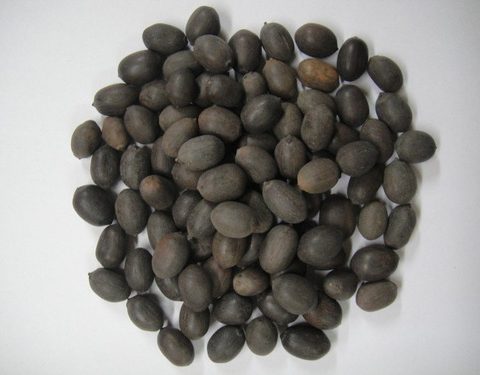
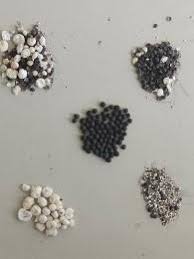
Note- Seeds of Makhana are round in shape and their colour varies from brown to black. Seed coat is approximately 1 mm thick. Seed size ranges from 5 to 15 mm in diameter. Seed is endospermic and has starch in endosperm. Pericarp lies between the seed coat and endosperm.

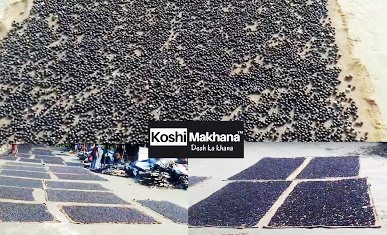
Pic soure-koshi makahana
Step-3:-
Grading of the makhana seed as per their size:-
The sundried makhana seed are then segregated according to their size or categorized into 5-7grades by help of wire strainer or a set of sieve/perforated mesh. Grading help the makhana seed to achieve a uniform size and also facilitates uniform heating of each seeds during roasting

Pic source-krishisheva
Step-4
Pre-heating of makhana seed to temper the kernel or hard coating:-
After grading of the sundried makhana seeds, traditionally, it is allowed to pre-heated in earthen cast iron pan at temperature appox 200-250 degree celcious for at least 5-6 minutes and stirred continuously during heating so that the moisture in the nuts or seeds reduced to approx. 20% and the makhana seed kernel gets tempered or slightly loosen the kernel within the hard seed coat.

Step-5:- Roasting & popping of the makhana seed:-
After pre-heating of the makhana seed, the tempered seed is once again roasted in batch wise in the cast iron pan at temperature more than 300 degree Celcious and allow to continuous stirring it resulting the tempered seed cracking the hard surface from the seed and then immediately transferred the hot cracking seed to a hard surface and suddenly crushed with wooden hammer or a flat metal containers so that the hard cracked surface removed from the puffed makahana kerenel.
As the hard shell breaks, the kernel pops out in expanded form, which is called Makhana pop or lawa. This is very laborious work and most important process technique which is traditionally done by hand. The yield is approx. 35-40% depending on the size of the makhana seed that means from 01 kg of raw makhana seed 350-400gms of puffed phool makhana can be obtain.
Note:-The edible part of makhana seed is called perisperm and the popped kernel is known as makhana

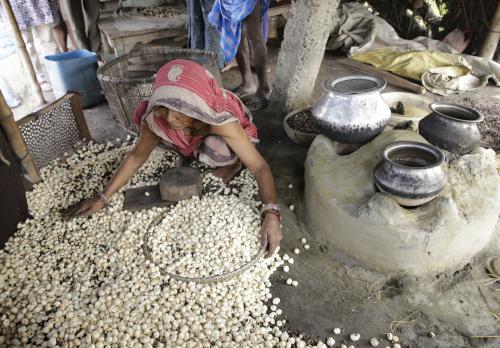
Pic source-downtoearth
Step-6:- Rubbing or polishing of puffed makhana kernel:-
A haul of white puffs are placed in a bamboo basket and then rubbed with palm so as to remove the residue of black seed coating or outer black coating. Rubbing technically known as polishing of the puffed makhana kernel which helps to gain shiny white color in the makhana
After polishing, the phool makhana lawa is then shorten or graded into two categories i.e Lawa & Thurri. The lawa is swollen and white with reddish spots whereas, thurri is semi-popped, hard and reddish in colour.
After shorting, it is then stored in plastic bags or gunny bags with plastic lining so that moisture don’t observed and then sold in the market.

Pic source-sciencedirect
Commercial Machine for popping of Makhana seed:-
With the advance of the technology, Indian council of agricultural research with help of CIPHET, Ludhina engineers have developed several machine which can process the makhana and commercially it is used in market.
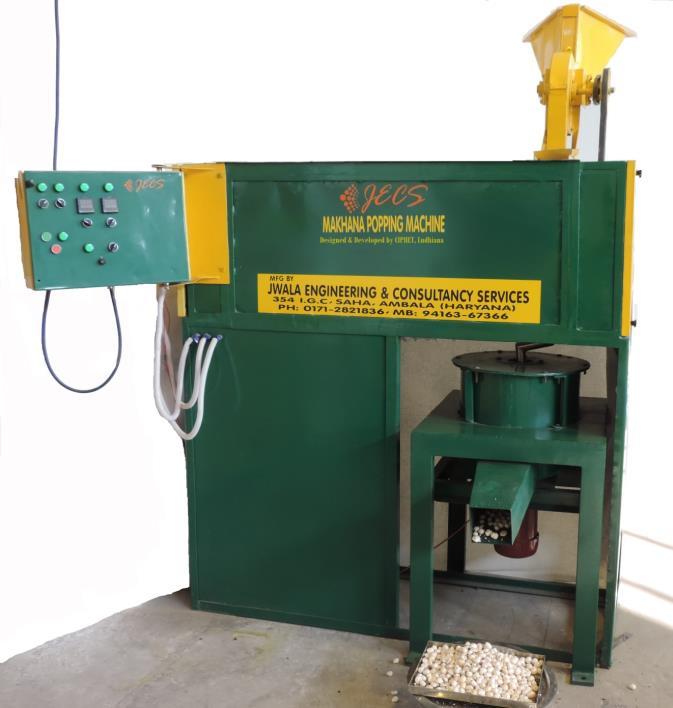
Pic source-Indian council of agricultural research (ICAR)
Common name of Makhana:-
- Prickly Waterlily, Prickly Water Lily, Gorgon Plant, Fox nut in English
- Makhana (मखाना ) or Phool makhana in Hindi, Urdu & sanskrit
- Thangjing in Manipuri
- Karuntamarai (மல்லாநி பத்மந்) in Tamil
- Mallani-padman (మెల్లునిపద్మన) in Telgu
Nutritional value of Makhana:-
Makhana is one of the most common dry fruits which is having very low fat content but high in carbohydrate, protein & minerals. The calorific value of raw makhana seed is approx. 360Kcal per 100gms whereas the puffed makhana kernel is approx. 328Kcal per 100gms.
The chemical constituents of puffed makhana kernel per 100gms are- 12.8gms of moisture, 76.9gms of carbohydrates, 9.7gms protein, 0.1gms fat, 0.02gms calcium, 0.9gms of phosphorus, dietary fibre- 7.6gms

Culinary use of Makhana:-
The Phool Makhana is very significance in our religious ceremonies or festivals and often offered to God as a form of Prashad during pooja. It is taken as a popular ‘fasting’ or vrat food prepared during Navratri , Ganesh Chaturthi and other occasions such as Makhane ka kheer, coconut makhana ke laddu, badam aur makhane ka kheer , makhane ka halwa etc.
It is one of the highest selling dry snacks served as a healthy substitute to popcorn. It is usually shallow fried in ghee & season with salt & pepper to make a heathy snacks.
It is also used in the preparation of several vegetarian dishes such as Navarattan korma,khoya makhana,cashew makhana mushroom curry, ,Aloo makhane ki subzi and Various rice dish preparation such as Navarattan pulao, almond, apple & makhane ke pulao, Veg kabab preparation such as aloo makhane ki tikki etc.
It is also used in making cookies such as makhana chocolate cookies
Health Benefits of Makhana
Makhana has high nutritional value as it is a rich source of proteins, carbohydrates, fiber, potassium, iron, and zinc. Makhana is superior to dry fruits such as almonds, walnut, coconut and cashew nut in term of sugar, protein, ascorbic acid and phenol content. Makhana seeds are low in saturated fats, sodium and cholesterol and are high in magnesium potassium and phosphorus. It contains easily digestible protein, carbohydrate, moisture, fat, total minerals, phosphorus and iron. These chemical constituents are very useful for human body and they also provide rich source of nutrition. It is avoiding constipation due to having high fiber.
It has Inflammatory properties due to rich in flavonoids, a chemical which have a positive effect on human body. It is also antioxidants properties.
Fox nuts help in detoxifying the organ and function properly.
Due to Rich in potassium and low in sodium, it is beneficial for people suffering from high blood pressure. Makhana helps in keeping the blood pressure under control and helps in maintaining the systolic blood pressure levels.
It also help to keep our body hydrated and maintain the water content.
Makhana is loaded with calcium, which help in maintaining the health of teeth and bones, therefore it is usually given to children to improve their bone strength.
Ayurveda properties of Makhana:-
According to Ayurveda, Makhana helps improve male sexual health as it increases sperm quality and quantity due to its aphrodisiac property. Eating Makhana might also help control diarrhea as its strong astringent property helps slow down the passage of stool through the digestive tract thereby reducing the frequency of passing stool.
Excessive consumption of Makhana might cause constipation, bloating and flatulence.
Ayurveda recommends makhana to be beneficial in Tridosas or three principal defects of the body especially in vita (rheumatic disorder) and pitta (bile disorder). Makhana alleviates Vata and Pitta Dosha. It strengthens the heart and is very useful in anemia.
Popular brand name of makhana:-
It is available in Indian market in Raw makhana and Roasted form makhana. There are several popular brand which is selling both the form of makhana. The average price range of Raw puffed makhana is in between Rs 800/- to Rs 1500/- per kg depending upon the brand name and quality of the makhana kernel. Whereas the Roasted form of makhana are in the price range of Rs 1500/- to Rs 2000/- per kg.
Example of popular brands are:-
- Vedika phoolmakhana
- Dharti makhana
- Rajbhog makhana
- Shakti sudh makhana
- Chuk de makhana
- Sattviko makhana
- Nature platter makhana
- Ashok dry fruit makhana
- Shri murli makhana
- Pro chef makhana
- Urban haat makhana
- Mr.Makhana
- True food makhana
- Kohinoor makhana

Kosi Makhana is india’s only manufacturer and supplier of organic makhana which is based in Saharsha (Bihar). This company is having plant for processing the organic makhana in saharaha (Bihar) which is highly mechanized.
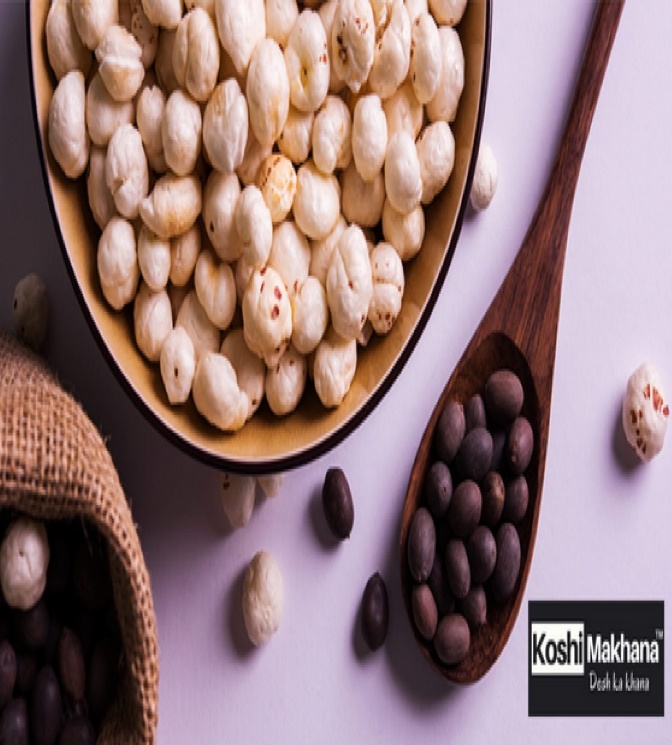
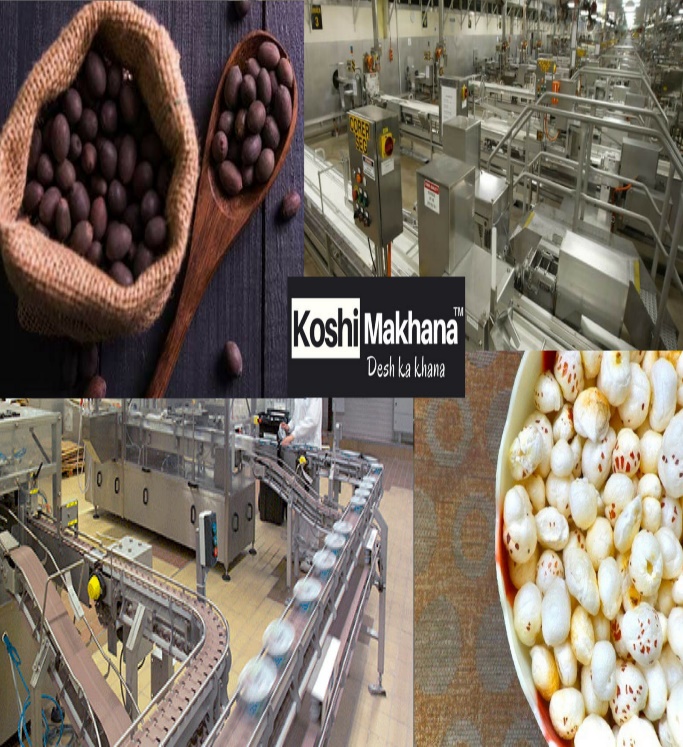
Pic source-koshimakhana.com
https://www.youtube.com/watch?v=o5kxnuAfrYI
Ref:-

